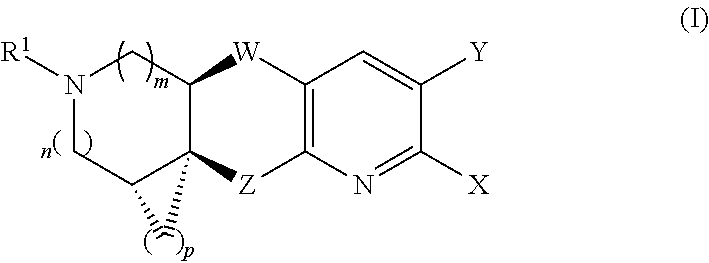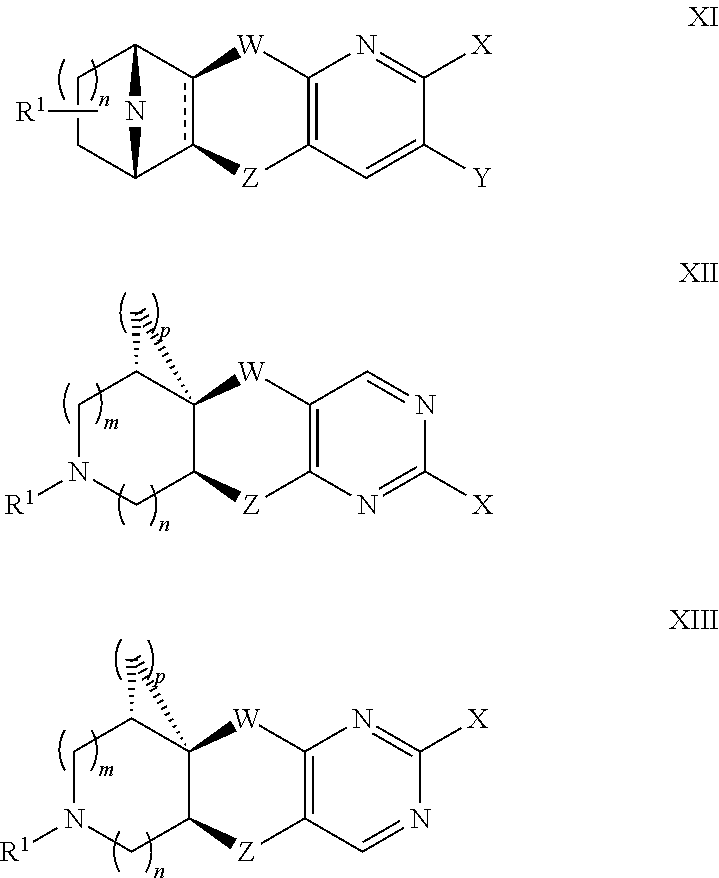Nicotinic acetylcholine receptor agonists
a technology agonist, which is applied in the field of can solve the problem of unmet needs in the art for additional nicotinic acetylcholine receptor agonists
- Summary
- Abstract
- Description
- Claims
- Application Information
AI Technical Summary
Benefits of technology
Problems solved by technology
Method used
Image
Examples
example 1
[0106]This example describes initial processing of material obtained from animals.
[0107]Collection of specimens of Epipedobates anthonyi (formerly E. tricolor), preparation of extracts and HPLC separation were essentially as described previously.9 Briefly, the alkaloid fraction from the methanolic extract of 183 skins (net 6 mL at 13 g skin / mL) was analyzed by HPLC-UV-MS using a Phenomenex Aqua 125 Å C18 column (4.6×250 mm) and a gradient of H2O / CH3CN, with each component containing 0.1% HOAc, from 90 to 50% H2O over 40 min and held 10 min. For biological analysis, otherwise identical runs were conducted with only UV detection and collection of the eluate into 96-well plates covering the interval of 4 to 64 min using an Isco Foxy 200 fraction collector. The collected fractions were acidified with HCl to suppress volatility, evaporated under nitrogen flow, sealed with PARAFILM™ and kept at −20° C. until use.
example 2
[0108]This example describes a bioassay of chromatography fractions obtained from the material described in Example 1.
[0109]Collected analytical scale fractions in 96-well plates were reconstituted in situ with 300 μL Hanks balanced salt solution containing 20 mM HEPES at pH 7.4 (HBSS / HEPES) and were used as such. Cell lines expressing various nicotinic receptors were maintained in culture and used for functional fluorescence assays including SH-SY5Y, IMR-32, TE-671, KXα3β4R2, KXα4β4R1, and KXα4β2R2, as previously described.9,11 Briefly, cells were plated onto 96-well poly-D-lysine-coated plates in Dulbecco's modified minimum essential media supplemented with 10% fetal bovine serum (supplemented with Geneticin G418 for KXα3β4R2, KXα4β4R1, and KXα4β2R2 cells) and grown to near confluence. The media was aspirated and the cells were gently washed with 2×100 μL HBSS / HEPES (pH 7.4). A solution of Molecular Devices no-wash membrane potential dye (30 μL) was added and the cells incubated i...
example 3
[0110]This example describes the isolation of phantasmidine (4).
[0111]Preparative isolation was conducted as previously described.9 Briefly, 5 mL of the extract was concentrated under a nitrogen flow to ˜0.3 mL and separated by HPLC in a similar fashion with collection in deep-well polypropylene plates using a Phenomenex Aqua 125 Å C18 column (10×250 mm) at 2.0 mL / min with collection of fractions at 0.25 mL / min over six injections. Fractions of this eluate, found to contain 4, were collected and analyzed by LC-APCI-MS, GC-MS in EI and CI (NH3, ND3) modes, GC-FTIR and microprobe NMR (500 MHz). The initially collected fractions were found to be insufficiently pure for unambiguous NMR analysis and were re-chromatographed as above. This provided material which was slightly impure, but allowed unambiguous identification of the NMR signals belonging to 4.
[0112]Phantasmidine (4).
[0113]E. anthonyi alkaloid extract LC peak, Rt 15.20 min, GC peak, Rt 14.66 min: UV (LC CH3CN / H2O, 0.05% HOAc) λ...
PUM
| Property | Measurement | Unit |
|---|---|---|
| body weight | aaaaa | aaaaa |
| dihedral angle | aaaaa | aaaaa |
| dihedral angle | aaaaa | aaaaa |
Abstract
Description
Claims
Application Information
 Login to View More
Login to View More - R&D
- Intellectual Property
- Life Sciences
- Materials
- Tech Scout
- Unparalleled Data Quality
- Higher Quality Content
- 60% Fewer Hallucinations
Browse by: Latest US Patents, China's latest patents, Technical Efficacy Thesaurus, Application Domain, Technology Topic, Popular Technical Reports.
© 2025 PatSnap. All rights reserved.Legal|Privacy policy|Modern Slavery Act Transparency Statement|Sitemap|About US| Contact US: help@patsnap.com



